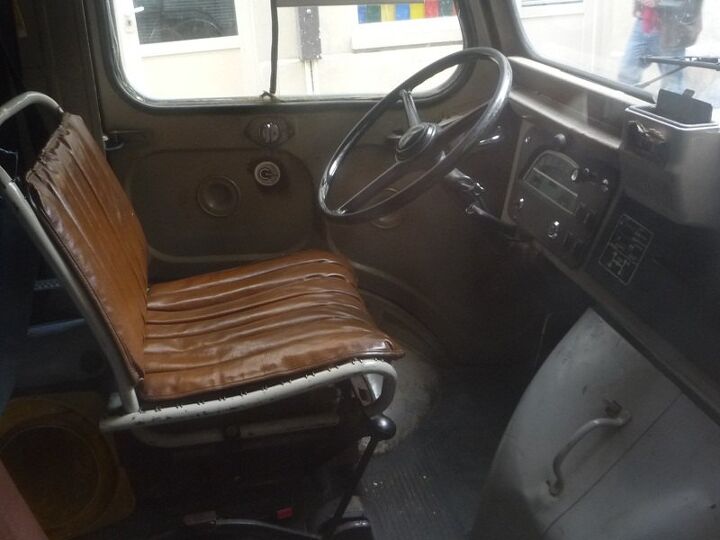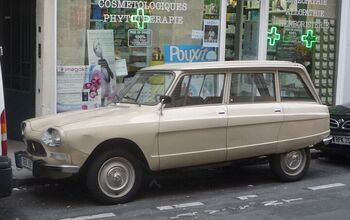Le Curbside Classic: Citroen H Van

I return from Paris fulfilled. This was a family trip, with a focus on culture, museums, food and window shopping; not cars. But in our walking haunts of Paris’ most colorful neighborhoods, I found exactly what I needed to keep CC going on its regular schedule: two classic little French cars, and one truck, to continue the trucks-on-Saturday tradition. And not just any old truck, but the most iconic French truck ever. The Citroen H Van’s distinctive appearance and corrugated panels exude everything that is the French approach to automotive solutions: technically innovative, eccentric yet practical, visually delightful (some may take exception), and with a timeless appeal. And I have my younger son to thank for finding it.
He’s not along for several reasons. But he requested that we bring him back a bottle of genuine French absinthe. We got an address for an absinthe purveyor, and finally found it after getting quite lost across the river near the Rue de Rosiers (best falafel pitas ever there). And in front of it was parked this H Van. The shop (green one above), like so many here, was the size of an American walk-in closet. How do they make a living from them? It’s great dealing with the knowledgeable and friendly owners of these little store-fronts; sure beats the surly clerk at Albersons.
Back to the H Van: Having successfully launched the revolutionary FWD Traction Avant sedan, in 1942 Citroen developed what is probably the first mass-produced FWD van, naturally using as many components from the sedan. The main difference was that the engine-transmission unit was turned 180 degrees, to get the motor out front, and out of the way.
The benefits of FWD in a van are all-too obvious, as the picture above makes clear: a very low cargo floor, due to the Citroen’s suspension that puts the floor at or below hub height. Almost all French vans and light trucks have been FWD since the H Van introduced its joys to the market.
The Citroen’s distinctive corrugated galvanized steel panels are also highly practical, since they have a degree of rigidity that allowed a more minimal supporting structure. The 2CV prototypes also used these corrugated panels, but only the hood made into the production version. Citroen was inspired by the pioneering Junkers monoplane of the late twenties, which in turn was the basis for the Ford Tri-motor (below), also known as the Tin Goose.
The H Van didn’t only borrow the corrugated panels, but the general styling as well, it seems. That won’t have been for the first time, though. And like an airplane, the H Van was quite light, just a hair over 3,000 lbs. Given that the 1911 cc four put out some 50 hp, the light (empty) weight was helpful, if not necessary. The early versions had a three-speed transmission, and a top speed of 78 km/h (48 mph). Life was lived slower then, especially in France.
The seats in this H Van appear to be similar to the 2CV’s, in having a thin upholstered cushion suspended from webbing attached to the seat frame rails.
The H Van had a long life, like so many of Citroen’s vehicles. After some thirty four years, the end came in 1981. And there were a number of variants built during that time, including longer and taller versions. A special ambulance model had the DS’ hydro pneumatic suspension fitted to the rear, to make the ride extra soft on the way to the hospital.
In the seventies, the H-van was the hippie van/camper of choice. Not surprisingly, the H Van still has an enthusiastic cult following. And like absinthe, some folks are still enjoying its peculiar pleasures. A votre santé, Will!

More by Paul Niedermeyer
Latest Car Reviews
Read moreLatest Product Reviews
Read moreRecent Comments
- Zipper69 "At least Lincoln finally learned to do a better job of not appearing to have raided the Ford parts bin"But they differentiate by being bland and unadventurous and lacking a clear brand image.
- Zipper69 "The worry is that vehicles could collect and share Americans' data with the Chinese government"Presumably, via your cellphone connection? Does the average Joe in the gig economy really have "data" that will change the balance of power?
- Zipper69 Honda seem to have a comprehensive range of sedans that sell well.
- Oberkanone How long do I have to stay in this job before I get a golden parachute?I'd lower the price of the V-Series models. Improve the quality of interiors across the entire line. I'd add a sedan larger then CT5. I'd require a financial review of Celestiq. If it's not a profit center it's gone. Styling updates in the vision of the XLR to existing models. 2+2 sports coupe woutd be added. Performance in the class of AMG GT and Porsche 911 at a price just under $100k. EV models would NOT be subsidized by ICE revenue.
- NJRide Let Cadillac be Cadillac, but in the context of 2024. As a new XT5 owner (the Emerald Green got me to buy an old design) I would have happy preferred a Lyriq hybrid. Some who really like the Lyriq's package but don't want an EV will buy another model. Most will go elsewhere. I love the V6 and good but easy to use infotainment. But I know my next car will probably be more electrified w more tech.I don't think anyone is confusing my car for a Blazer but i agree the XT6 is too derivative. Frankly the Enclave looks more prestigious. The Escalade still has got it, though I would love to see the ESV make a comeback. I still think GM missed the boat by not making a Colorado based mini-Blazer and Escalade. I don't get the 2 sedans. I feel a slightly larger and more distinctly Cadillac sedan would sell better. They also need to advertise beyond the Lyriq. I don't feel other luxury players are exactly hitting it out of the park right now so a strengthened Cadillac could regain share.






































Comments
Join the conversation
You didn't have to travel that far to see an H van in regular use. Portland Citroen guru Bill Lonseth has one that he uses as a shop van, painted in Ikea blue and yellow, or at least it was in 1995.
When I was in my mid-50s, I worked for Fedex Ground for a couple of years as a utility driver, never knowing each morning where I would be sent out in a 20-county Southern Minnesota region. I begged for a van like this, with its low step up height and front wheel drive. If Fedex had let me, I would have bought the nearest American equivalent, the Utilimaster Aeromate, built on a Mopar minivan FWD running gear. Having owned two Simca 1204 GLS cars during my early farming days in North Dakota, I know the French are really good at designing suspension systems for very bad roads. The standard Fedex Ground stepvan, based on a two-ton I-H farm truck chassis, is an oversprung pig, unable to get down unplowed farm driveways without sliding all over the place. On washboard gravel roads, I had to match the frequency of the ruts with precise control of my ground speed to keep boxes from bouncing off the shelves. The Citroen H has the right morphology for a delivery van. Why can't manufacturers make a modern version?